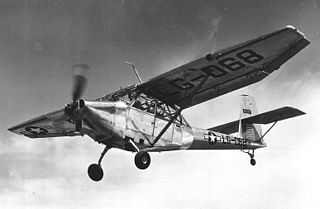
The Stinson L-13 is a US military utility aircraft first flown in 1945.

The Consolidated Vultee XP-81 is a development of the Consolidated Vultee Aircraft Corporation to build a single seat, long range escort fighter that combined use of both turbojet and turboprop engines. Although promising, the lack of suitable engines combined with the end of World War II doomed the project.

The Consolidated XP4Y Corregidor was an American twin-engined long-range maritime patrol flying boat built by Consolidated Aircraft for the United States Navy. Only one was built and a production order for 200 was cancelled.

The Barkley-Grow T8P-1 was an airliner developed in the United States shortly before the Second World War. Although it saw limited production, the type was well-received as a bush plane in Canada.

The Consolidated Model 21 was an American two-seat training aircraft built by the Consolidated Aircraft Company. It was used by the United States Army Air Corps with the designation PT-11 and the United States Coast Guard under the designation N4Y.

The Consolidated Model 17 Fleetster was a 1920s American light transport monoplane aircraft built by the Consolidated Aircraft Corporation. There was several closely related types the Model 17, Model 18, Model 20; then the C-11, C-22, and XBY military versions.

The Dayton-Wright T-4 Messenger was a light, single-seat reconnaissance aircraft built in the United States by the Dayton-Wright Company in 1918 in the hope of gaining a production contract from the United States Army. It was a small conventional single-bay biplane with a neatly streamlined fuselage and staggered, equal-span wings. The undercarriage was of fixed tailskid type and the pilot sat in an open cockpit. Although diminutive, the design in fact started life as a scaled-up version of the Dayton-Wright Bug and shared a family resemblance to the de Havilland DH.4 that Dayton-Wright was building under licence during World War I. When the US Army was not interested in the aircraft, plans were made to sell it on the civil market, but these came to nothing and the prototype was the only example ever built.
The Thomas Brothers T-2 was an American-built biplane which served with the Royal Navy.

The Thomas-Morse MB-2 was an open-cockpit biplane fighter manufactured by Thomas-Morse Aircraft for the U.S. Army Air Service in 1918.

The Stinson SM-6000 Airliner was a 1930s three-engined (trimotor) ten-passenger airliner designed and built by the Stinson Aircraft Corporation. The SM-6000 was a high-wing braced monoplane with room for a pilot and a cabin for ten passengers. It was powered by three 215 hp (160 kW) Lycoming R-680 engines strut-mounted one each side above the main landing gear units and one in the nose. A number of variants were built mainly with improved interiors. In 1932 the Model U Airliner was produced which had low-set stub wings with additional two engines mounted on each wing complementing the existing nose mounted center engine.

The Hall XP2H-1 was an American prototype four-engined biplane flying boat of the 1930s. Intended as an experimental very-long-range maritime patrol aircraft, a single example was built. The XP2H-1 was the largest four engine biplane aircraft ever procured by the US Navy.

The Convair Model 48 Charger was a prototype light attack and observation aircraft of the 1960s, developed to meet a requirement for a dedicated counter-insurgency (COIN) aircraft. It was a two-seat, twin-boom aircraft powered by two turboprop engines which lost out to the North American Rockwell OV-10 Bronco of similar layout. Only the single prototype Model 48 was built, and this turned out to be the last complete aircraft constructed by Convair.

The Convair Model 118 ConvAirCar was a prototype flying car of which two were built. Intended for mainstream consumers, two prototypes were built and flown. The first prototype was lost in an accident due to fuel exhaustion. Subsequently, the second prototype was rebuilt from the damaged aircraft and flown. By that time, little enthusiasm remained for the project and the program ended shortly thereafter.

The Boeing Model 116 ConvAirCar was a prototype roadable aircraft that was intended to exploit the post-war aviation market. The vehicle was further developed into the Convair Model 118, but neither type achieved production status.

The Thomas-Morse R-5 also known as the TM-22 was an American single-engined parasol monoplane racing aircraft of the 1920s. Two were built for the United States Army Air Service in 1922, but after competing in the 1922 Pulitzer Trophy Race the type was abandoned.

The Thomas-Morse MB-4 was a prototype American mailplane of the 1920s. It was of unusual design, being a biplane with twin fuselages housing the crew of two and a central nacelle which carried the aircraft's twin engines in a push-pull configuration.

The Consolidated XB2Y was an American prototype single-engined dive bomber of the 1930s. It was intended to meet a United States Navy requirement for a carrier-based dive bomber, but was unsuccessful, only a single example being built.

The Stinson Model O was an American single-engined military trainer aircraft of the 1930s designed built by the Stinson Aircraft Company. Based on the Stinson SR, the Model O was designed to meet a requirement of the Honduran Air Force, forming the initial equipment of that air arm.

The Thomas-Morse TM-24 was a prototype American two-seat observation aircraft of the 1920s. A single example was built in 1925, but no production followed.

The Stinson Model R was an American light aircraft built by the Stinson Aircraft Company in the early 1930s. It was a single-engine high-winged monoplane, developed from the Stinson Junior. 39 units were built.
This page is based on this
Wikipedia article Text is available under the
CC BY-SA 4.0 license; additional terms may apply.
Images, videos and audio are available under their respective licenses.



















